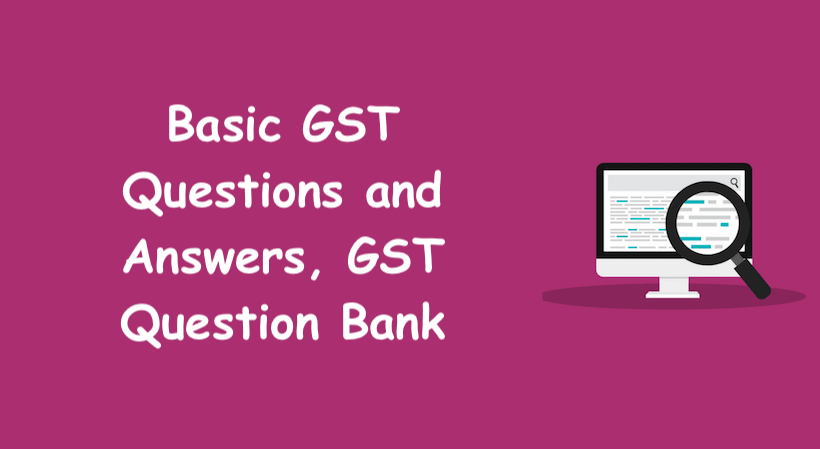GST means tax on supply of goods, or services or both except taxes on the supply of the alcoholic liquor for human consumption [Article 366(12A) of the Constitution of India]. Further, GST is a Value added tax on the supply of goods and/or services. GST is a single tax at a national level to be levied at all stages right from manufacturing to final consumption. Under GST every person is liable to pay tax on his output and is entitled to get input tax credit (ITC) on tax paid on its inputs, input services and capital goods. Therefore, it is a tax on the value addition only. Ultimately the final consumer shall bear the burden of tax under GST.
GST Question bank
1. What is GST?
Ans. GST is Goods and service tax. GST is a tax on supply of goods, or services except alcoholic liquor on human consumption.
2. What are the taxes subsumed into GST?
Advertisement
Ans. Central taxes subsumed in GST: Cenvat, Additional duty of excise, Excise duty under medical and toilet preparation, service tax, additional customs duty, special additional duty (SAD), Central surcharge and cess State taxes subsumed in GST: State Vat/ Sales Tax, Central sales tax, octroi and entry tax, luxury tax, taxes on lottery, betting and gambling, state cess and surcharge
3. What are the taxes not subsumed into GST?
Ans. Basic Customs Duty, Electricity Duty, Taxes on alcoholic liquor for human consumption, Tax on Sale of land and Building, Tax on Securities and Fee chargeable under State laws like fee chargeable for sale of agriculture produce popularly known as Mandi fee has not been subsumed into GST.
4. What is GST Council?
Ans. GST Council is a constitutional body for making recommendations to the Union and states on issues relating to GST. It is chaired by Finance Minister and other members are the Union State Minister of Revenue or Finance and Ministers in-charge of Finance or Taxation of all the States.
5. Who shall pay GST?
Ans. Taxable person is required to pay GST. Taxable person is a person registered or required to be registered under GST
6. What is the taxable event under GST?
Ans. Taxable event in GST is supply.
7. How to determine Inter and Intra State Supplies under GST?
Ans. Where location of supplier and place of supply is in two different states or union territories, it is a case of inter-state supply. But where location of supplier and place of supply is in same state or union territory it is intra state supply.
8. What are the Shortcomings of present tax structure leading to concept of GST?
Ans.
- Piecemeal credit of taxes
- No credit of Central Sales Tax.
- No credit of vat paid in other state.
- Cascading effect of taxes by charging vat on value of goods including excise duty.
- No system of matching turnover in direct and indirect tax.
- Assessable value was in some cases more than value of contract
9. What are the functions of GST Council?
Ans.
- Recommendation on taxes to be subsumed
- Goods and services to be exempted
- Framing of model GST law.
- Principles for levy and apportionment of IGST
- Principles that govern place of supply.
- Thresh hold limit of turnover which may be exempted from GST
- Determination of GST rates
- Special provisions for certain states
10. How the GST Constitutional Amendment bill was converted into GST Amendment Act?
Ans. Constitutional bill was passed by Lok sabha on 19-12-2014. Rajya sabha bill passed the bill on 03-08-16. After ratification by more than 50% of the States presidential assent was given on 08-09-16 and was put into force from 16-09-16. Thus the Constitutional amendment bill was converted into constitutional amendment act
MCQs on GST
1. GST is tax on
- (a) Sale
- (b) Removal
- (c) Supply
- (d) Manufacture
Ans. (c) Supply
2. GST covers
- (a) Goods
- (b) Services
- (c) Goods and Services
- (d) All of the above
Ans. (d) All of the above
3. Following taxes have been subsumed into GST
- (a) State taxes only
- (b) Central Taxes only
- (c) None of the above
- (d) Both Central taxes and State taxes
Ans. (d) Both Central taxes and State taxes
4. Who is required to pay GST?
- (a) Registered person only
- (b) Every person
- (c) Taxable person
- (d) All of the above
Ans. (c) Taxable person
5. Interstate supply is involved where
- (a) Location of supplier and place of supply is in the same State
- (b) Location of supplier and place of supply is in two different States
- (c) Both of the above
- (d) None of the above
Ans. (b) Location of supplier and place of supply is in two different States
6. GST in India is based on:
- (a) Dual system
- (b) Single system
- (c) None of the Above
- (d) Quadruplicate system
Ans. (b) Single system
7. GST registration is required when the aggregate turnover exceeds:
- (a) Rs. 5 lacs
- (b) Rs. 12 lacs
- (c) Rs. 15 lacs
- (d) Rs. 20 lacs
Ans. (d) Rs. 20 lacs
8. GST is a
- (a) Value added tax
- (b) Tax on outward supplies
- (c) Tax on Inward supplies
- (d) None of the above
Ans. (a) Value added tax
